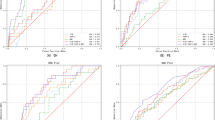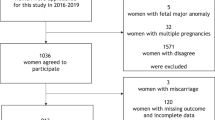Abstract
The aim of the present study was to determine a predictive model for early-onset preeclampsia with fetal growth restriction (FGR) to be used at 11+0 to 13+6 gestational weeks, by combining the maternal serum level of pregnancy-associated plasma protein-A (PAPP-A), placental growth factor (PLGF), placental protein 13 (PP13), soluble endoglin (sEng), mean arterial pressure (MAP), and uterine artery Doppler. This was a retrospective cohort study of 4453 pregnant women. Uterine artery Doppler examination was conducted in the first trimester. Maternal serum PAPP-A, PLGF, PP13, and sEng were measured. Mean arterial pressure was obtained. Women were classified as with/without early-onset preeclampsia, and women with preeclampsia were classified as with/without FGR. Receiver operating characteristic analysis was performed to determine the value of the model. There were 30 and 32 pregnant women with early-onset preeclampsia with and without FGR. The diagnosis rate of early-onset preeclampsia with FGR was 67.4% using the predictive model when the false positive rate was set at 5% and 73.2% when the false positive rate was 10%. The predictive model (MAP, uterine artery Doppler measurements, and serum biomarkers) had some predictive value for the early diagnosis (11+0 to 13+6 gestational weeks) of early-onset preeclampsia with FGR.
Similar content being viewed by others
References
Leeman L, Fontaine P. Hypertensive disorders of pregnancy. Am Fam Physician. 2008;78(1):93–100.
Lindheimer MD, Taler SJ, Cunningham FG, American Society of Hypertension. ASH position paper: hypertension in pregnancy. J Clin Hypertens (Greenwich). 2009;11(4):214–225.
Ananth CV, Keyes KM, Wapner RJ. Pre-eclampsia rates in the United States, 1980-2010: age-period-cohort analysis. BMJ. 2013;347:f6564.
Waterstone M, Bewley S, Wolfe C. Incidence and predictors of severe obstetric morbidity: case-control study. BMJ. 2001;322(7294):1089–1093; discussion 1093-1084.
Steegers EA, von Dadelszen P, Duvekot JJ, Pijnenborg R. Pre-eclampsia. Lancet. 2010;376(9741):631–644.
Magee LA, Pels A, Helewa M, et al.; Canadian Hypertensive Disorders of Pregnancy Working Group. Diagnosis, evaluation, and management of the hypertensive disorders of pregnancy: executive summary [In English, French]. J Obstet Gynaecol Can. 2014;36(5):416–441.
Polsani S, Phipps E, Jim B. Emerging new biomarkers of preeclampsia. Adv Chronic Kidney Dis. 2013;20(3):271–279.
Carty DM, Delles C, Dominiczak AF. Novel biomarkers for predicting preeclampsia. Trends Cardiovasc Med. 2008;18(5):186–194.
Lovgren TR, Dugoff L, Galan HL. Uterine artery Doppler and prediction of preeclampsia. Clin Obstet Gynecol. 2010;53(4):888–898.
Myatt L, Clifton RG, Roberts JM, et al; Eunice Kennedy Shriver National Institute of Child Health and Human Development (NICHD) Maternal-Fetal Medicine Units Network (MFMU). The utility of uterine artery Doppler velocimetry in prediction of preeclampsia in a low-risk population. Obstet Gynecol. 2012;120(4):815–822.
Cnossen JS, Morris RK, ter Riet G, et al. Use of uterine artery Doppler ultrasonography to predict pre-eclampsia and intrauterine growth restriction: a systematic review and bivariable meta-analysis. CMAJ. 2008;178(6):701–711.
American College of Obstetricians and Gynecologists. Diagnosis and Management of Preeclampsia and Eclampsia. ACOG Practice Bulletin no. 33. Washington, DC: The College; 2002.
Spencer K, Liao AW, Ong CY, Geerts L, Nicolaides KH. First trimester maternal serum placenta growth factor (PIGF) concentrations in pregnancies with fetal trisomy 21 or trisomy 18. Prenat Diagn. 2001;21(9):718–722.
Plasencia W, Maiz N, Bonino S, Kaihura C, Nicolaides KH. Uterine artery Doppler at 11 + 0 to 13 + 6 weeks in the prediction of pre-eclampsia. Ultrasound Obstet Gynecol. 2007;30(5):742–749.
Noris M, Perico N, Remuzzi G. Mechanisms of disease: pre-eclampsia. Nat Clin Pract Nephrol. 2005;1(2):98–114; quiz 120.
Palei AC, Spradley FT, Warrington JP, George EM, Granger JP. Pathophysiology of hypertension in pre-eclampsia: a lesson in integrative physiology. Acta Physiol (Oxf). 2013;208(3):224–233.
Wortelboer EJ, Koster MP, Cuckle HS, Stoutenbeek PH, Schielen PC, Visser GH. First-trimester placental protein 13 and placental growth factor: markers for identification of women destined to develop early-onset pre-eclampsia. BJOG. 2010;117(11):1384–1389.
Pandya P, Wright D, Syngelaki A, Akolekar R, Nicolaides KH. Maternal serum placental growth factor in prospective screening for aneuploidies at 8-13 weeks’ gestation. Fetal Diagn Ther. 2012;31(2):87–93.
Cowans NJ, Spencer K, Meiri H. First-trimester maternal placental protein 13 levels in pregnancies resulting in adverse outcomes. Prenat Diagn. 2008;28(2):121–125.
Chafetz I, Kuhnreich I, Sammar M, et al. First-trimester placental protein 13 screening for preeclampsia and intrauterine growth restriction. Am J Obstet Gynecol. 2007;197(1):35.e31–e37.
Verlohren S, Herraiz I, Lapaire O, et al. The sFlt-1/PlGF ratio in different types of hypertensive pregnancy disorders and its prognostic potential in preeclamptic patients. Am J Obstet Gynecol. 2012;206(1):58.e51–e58.
Poon LC, Zaragoza E, Akolekar R, Anagnostopoulos E, Nicolaides KH. Maternal serum placental growth factor (PlGF) in small for gestational age pregnancy at 11(+0) to 13(+6) weeks of gestation. Prenat Diagn. 2008;28(12):1110–1115.
Gilbert JS, Ryan MJ, LaMarca BB, Sedeek M, Murphy SR, Granger JP. Pathophysiology of hypertension during preeclampsia: linking placental ischemia with endothelial dysfunction. Am J Physiol Heart Circ Physiol. 2008;294(2):H541–H550.
Ghosh SK, Raheja S, Tuli A, Raghunandan C, Agarwal S. Can maternal serum placental growth factor estimation in early second trimester predict the occurrence of early onset preeclampsia and/or early onset intrauterine growth restriction? a prospective cohort study. J Obstet Gynaecol Res. 2013;39(5):881–890.
Ghosh SK, Raheja S, Tuli A, Raghunandan C, Agarwal S. Is serum placental growth factor more effective as a biomarker in predicting early onset preeclampsia in early second trimester than in first trimester of pregnancy? Arch Gynecol Obstet 2013;287(5):865–873.
Rana S, Karumanchi SA, Levine RJ, et al. Sequential changes in antiangiogenic factors in early pregnancy and risk of developing preeclampsia. Hypertension. 2007;50(1):137–142.
Guzin K, Tomruk S, Tuncay YA, et al. The relation of increased uterine artery blood flow resistance and impaired trophoblast invasion in pre-eclamptic pregnancies. Arch Gynecol Obstet 2005;272(4):283–288.
Melchiorre K, Wormald B, Leslie K, Bhide A, Thilaganathan B. First-trimester uterine artery Doppler indices in term and preterm pre-eclampsia. Ultrasound Obstet Gynecol 2008;32(2):133–137.
Odibo AO, Zhong Y, Goetzinger KR, et al. First-trimester placental protein 13, PAPP-A, uterine artery Doppler and maternal characteristics in the prediction of pre-eclampsia. Placenta. 2011;32(8):598–602.
Kuc S, Wortelboer EJ, van Rijn BB, Franx A, Visser GH, Schielen PC. Evaluation of 7 serum biomarkers and uterine artery Doppler ultrasound for first-trimester prediction of preeclampsia: a systematic review. Obstet Gynecol Surv. 2011;66(4):225–239.
Poon LC, Karagiannis G, Staboulidou I, Shafiei A, Nicolaides KH. Reference range of birth weight with gestation and first-trimester prediction of small-for-gestation neonates. Prenat Diagn. 2011;31(1):58–65.
Author information
Authors and Affiliations
Corresponding author
Rights and permissions
About this article
Cite this article
Chang, Y., Chen, X., Cui, HY. et al. New Predictive Model at 11+0 to 13+6 Gestational Weeks for Early-Onset Preeclampsia With Fetal Growth Restriction. Reprod. Sci. 24, 783–789 (2017). https://doi.org/10.1177/1933719116669053
Published:
Issue Date:
DOI: https://doi.org/10.1177/1933719116669053




